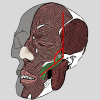Investigating the Contraction Pattern of the Zygomaticus Major Muscle and its Clinical Relevance: A Functional MRI Study
- PMID: 38413445
- PMCID: PMC11281949
- DOI: 10.1007/s00266-024-03876-8
Investigating the Contraction Pattern of the Zygomaticus Major Muscle and its Clinical Relevance: A Functional MRI Study
Abstract
Background: Our understanding of facial anatomy has significantly evolved, yet the detailed contraction patterns of facial muscles and their presentation during clinical imaging remain largely unexplored. Understanding the contraction patterns and visual presentation of these muscles, particularly the zygomaticus major could enhance pre-surgical facial assessments and the development of new treatment strategies.
Methods: A total of 34 healthy young individuals (17 female, 17 male) with a mean age of 23.6 (2.4) years [range: 20-30] were investigated regarding the length, thickness, width, and angle of the zygomaticus major muscle in five different facial expressions (i.e., repose, anger, joy, surprise, and sadness) utilizing MR imaging.
Results: Joyful expressions caused a reduction in muscle length to 85.6% of its original length and an increase in width (103.4%), thickness (108.4%), and facial angle (2.72°) when compared to that in repose, suggesting isotonic contraction. Conversely, expressions of anger, surprise, and sadness generally led to muscle stretching, seen through changes in length (98.9%, 104.3%, and 102.7%, respectively), width (98.8%, 96.5%, and 99.4%, respectively), and thickness (91.2%, 91.0%, and 102.7%, respectively), with variable alterations in facial angle (0.55°, 1.85°, and 1.00°, respectively) depending on the specific expression.
Conclusion: This MRI-based study indicates that the zygomaticus major muscle experiences isotonic contraction, characterized by decreased length and increased width and thickness. The findings underline the importance of muscle thickness as a reliable parameter in assessing facial muscle function and offer valuable guidance for practitioners in accurately evaluating muscle performance during different facial expressions.
No level assigned: This journal requires that authors assign a level of evidence to each submission to which Evidence-Based Medicine rankings are applicable. This excludes Review Articles, Book Reviews, and manuscripts that concern Basic Science, Animal Studies, Cadaver Studies, and Experimental Studies. For a full description of these Evidence-Based Medicine ratings, please refer to the Table of Contents or the online Instructions to Authors www.springer.com/00266 .
Keywords: Contraction pattern; Facial anatomy; Facial muscle; Muscle physiology; Zygomaticus major muscle.
© 2024. The Author(s).
Conflict of interest statement
The authors declared no potential conflicts of interest with respect to the research, authorship, and publication of this article.
Figures





Similar articles
-
Exploratory Analysis of Upper Facial Muscle Interplay During Emotional Expressions: Magnetic Resonance Imaging (MRI) Insights From Young, Caucasian, Toxin-naïve Individuals.Aesthet Surg J. 2025 Mar 17;45(4):414-421. doi: 10.1093/asj/sjae246. Aesthet Surg J. 2025. PMID: 39696998
-
Understanding the Interplay Between Skin, Fascia, and Muscles of the Midface in Facial Aging.Aesthetic Plast Surg. 2024 Sep;48(18):3568-3576. doi: 10.1007/s00266-024-04070-6. Epub 2024 May 9. Aesthetic Plast Surg. 2024. PMID: 38724637
-
Anatomy of Forehead, Glabellar, Nasal and Orbital Muscles, and Their Correlation with Distinctive Patterns of Skin Lines on the Upper Third of the Face: Reviewing Concepts.Aesthetic Plast Surg. 2016 Dec;40(6):962-971. doi: 10.1007/s00266-016-0712-z. Epub 2016 Oct 14. Aesthetic Plast Surg. 2016. PMID: 27743084 Review.
-
The Relationship Between Glabellar Contraction Patterns and Glabellar Muscle Anatomy: A Magnetic Resonance Imaging-based Study.Aesthet Surg J. 2024 Dec 12;45(1):NP8-NP15. doi: 10.1093/asj/sjae202. Aesthet Surg J. 2024. PMID: 39351911
-
A Bibliometric Analysis of the 50 Most Cited Articles on Body Contouring Surgery After Massive Weight Loss.Aesthetic Plast Surg. 2024 Jun;48(11):2132-2141. doi: 10.1007/s00266-024-03854-0. Epub 2024 Feb 12. Aesthetic Plast Surg. 2024. PMID: 38347130 Review.
Cited by
-
Evaluation of zygomaticus major muscle and lip-closing force in orthognathic surgery: retrospective study.Maxillofac Plast Reconstr Surg. 2025 May 21;47(1):10. doi: 10.1186/s40902-025-00466-9. Maxillofac Plast Reconstr Surg. 2025. PMID: 40397351 Free PMC article.
References
MeSH terms
LinkOut - more resources
Full Text Sources
Medical

